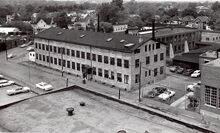| Zeta Tech | |

| |
| Political Information | |
| Type of Government: | Company Executive |
| Motto: | 'Building a better humanity for the future' |
| Societal Information | |
| Headquarters: | Detroit, Michigan |
| Historical Information | |
| Founded: | 19th Century |
| Dissolved: | 2077 |
| Policy Information | |
| Goals: | Profit, Advancing humanity |
| Status: | Defunct |
Before the Great War, Zeta Tech was an American corporation that was involved in a large number of different fields. Under the direction of its last CEO, the company began research into a number of fields that would have ongoing, lasting implications.
History
Originally founded in the 19th century as the Ace Typewriter Company, the entity that eventually became known as Zeta Tech grew through a combination of mergers, buyouts and opportunism. Devouring numerous other companies along the way, many by less then legal means, by the mid 21st century, Zeta Tech had become a massive conglomerate with its fingers in numerous different industries and fields. While the company’s primary focus remained manufacturing and heavy industry, it also had interests in other fields including (but not limited to) aviation, energy, weapons, automobiles, transport, robotics, electronics, personal computing, construction and pet supplies.
Despite this size (or possibly because of it), the company was badly effected by the combination of resource shortages and the subsequent resource wars as well as the downturn of the global economy. By 2065, the company was floundering badly, with many of its divisions haemorrhaging money while its structure had become massively unwieldy and overly complicated, slow to respond and dominated by middle managers who were more protective of their own jobs then the company’s health.
Into this mess entered Milton Oxen, a billionaire wunderkind graduate of CIT. Hired by the board to “fix” the company, he used his wealth (and no small measure of illegal influence) to take full control of it instead. He engaged in an ambitious and wide-ranging restructuring program that saw many fringe or non-profitable divisions sold off or shut down completely. At the same time, the profitable divisions were given massive boosts to research and development to ensure they stayed ahead. Many of the old guard who had resisted change in past were quietly let go or forced into retirement, one way or the other.
However, Oxen’s ambitions did not end at just restructuring; rather, he had a vision for the future and Zeta Tech was merely a means to that end. An avid futurist (and transhumnist), Oxen felt that a nuclear war with China was inevitable, and that no nation would survive the inevitable conflict. Rather then attempt to alleviate such a war, he intended to use it to advance humanity and reshape it into something greater that would be able to not only survive in a post-nuclear world, but actively thrive and advance itself. Oxen’s vision of humanity lay in a mingling of man and machine, becoming more powerful and capable though the blending of flesh and technology.
To this end, he devoted a considerable amount of Zeta’s resources, not to mention his own money, to the construction of a secret cybernetics division. This group was charged with the design, creation, development and implantation of various augmentations that could be used to ‘improve’ mankind. To aid in their work, he gained the cooperation of several US Army Generals who were interested in the millitary benefits of such technologies. Through them, Oxen gained key allies and influence, as well as access to some otherwise restricted technologies. They also provided him with a stream of test subjects, drawn from death-row inmates or Canadian dissidents.
While the research proceeded and showed some promise, Oxen became concerned about the pace of the work. Initial failure rates were high, resulting in undesirable side effects in test subjects such as rejection of the augmentations, schizophrenia, various physical complications and death. The work blew out its original budget numerous times, resulting in Oxen pouring more of his company’s money, as well as his own, into it. His secret backers also began to become cagier, with several advocating more known and proven technologies such as Robotics and Power Armour instead.
By mid-2077, Oxen was showing signs of deteriorating sanity and paranoia. He was concerned that a nuclear war was inevitable and that he would not be ready for it. In the meantime, the company was suffering from massive losses as this secret project drained money from everything else. Several key breakthroughs in August-September of 2077 helped alleviate the tension somewhat, with the researchers reporting that the failure rates had been reduced to acceptable levels. Desperate for a solution, Oxen signed off on mass production of the implants, with an anticipated delivery date of the first production run by November 1, 2077.
Already becoming somewhat reclusive, Oxen vanished from sight completely in mid-October 2077. He continued to issue orders to the company, but did such remotely. In his last remote board meeting, he confidently predicted a return to profitability in the first quarter of 2078.
Instead, the Great War struck first, effectively destroying the company. Most of Zeta Tech’s facilities were destroyed in the initial nuclear exchange, effectively wiping it from the face of the earth along with most of human civilisation. Those facilities that did survive either lost their personnel to radiation or other side effects, or were abandoned in the weeks and months that followed the conflict. Milton Oxen himself disappeared days before the war, and remained unaccounted for. By 2287, very little evidence remained that Zeta Tech ever existed.
Description
At the peak of its power, Zeta Tech was a massive firm that stretched across North America and beyond. It was involved with numerous different fields and industries, and possessed considerable influence beyond that. While not as massive as many other pre-war companies such as RobCo or Poisdeon Energy, Zeta’s key strengths lay in its diversity and a CEO that was willing to do whatever it took to achieve his personal goals, regardless of how insane they might have been. It was this latter element that created what might be it’s biggest single legacy in the form of research into the field of cybernetics and human augmentation.
The company effectively ceased to exist with the Great War, and most of it was simply destroyed in the conflict. Today, for the most part, outside of that one key field, it lives on through pre-war artefacts and junk, the origins of which are largely lost to time.
Facilities
Before the war, Zeta Tech possessed numerous facilities across North America, as well as international branches. While most of these have been destroyed, fallen into ruin or picked clean by looters, several of them remain to the present day.
Zeta Tech Headquarters

Zeta Tech headquarters, circa 2287
Located in downtown Detroit, this high-rise building was the home of Zeta Tech for years and the headquarters of its worldwide operations. Originally constructed in the early 21st Century, the building underwent numerous renovations and overhauls during its operational life. Under Milton Oxen’s reign as CEO, the building underwent further modifications, albeit done largely in secret and concealed from the majority of the staff.
While the tower still stands, it has suffered badly over the years from the damage of the Great War and generations of neglect. A good chunk of it has simply collapsed, the debris adding to the considerable maze that is the streets of the Detroit Downtown. Portions of the remaining interior are no longer accessible either, having collapsed or been choked with debris. Over the years, what is left of the building has been periodically occupied by different groups, including Feral Ghouls and Raiders. Presently it is the home of David David David David David David Plop, who uses it as a location from which to snipe at whatever grabs his attention.
Ace Typewriter Factory No. 1

Ace Typewriter Factory No. 1 circa 2070
Located outside of Clay Center, Kansas, the Ace Typewriter Factory No. 1 was the seed from which Zeta Tech would eventually grow. Despite how much it diversified, grew and contracted, the company always maintained a presence in the typewriter industry and continued to manufacture at the same site. Over the years, the factory was rebuilt and expanded numerous times to the point that nothing remained of the original structure.
Under Milton Oxen, the factory underwent another modification, this time somewhat different to its past. Effectively closed down, it was rebuilt into his secret cybernetics research facility, where work was done on human augmentation and implantation. At the same time, a series of assembly lines were constructed to mass-produce augmentations once they were perfected. Below ground, the factory had considerable laboratory and medical facilities for experimentation and development.
Production had only just begun when the Great War had broken out, with the first few production runs stockpiled for transport. While the building survived intact, the majority of the staff either died in the fallout or fled. At least one remained behind, however, to terminate the remaining test subjects in the name of security. After lying idle for over two centuries, the factory was rediscovered in 2284, and became the headquarters for the nascent Iron Klaw raider gang, its products used as the basis for their own transhumanist agenda.
| This has been written by KayEmm. Please contact this user before editing this article. |
